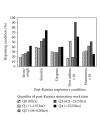Respiratory health effects associated with restoration work in post-Hurricane Katrina New Orleans
- PMID: 23365586
- PMCID: PMC3529447
- DOI: 10.1155/2012/462478
Respiratory health effects associated with restoration work in post-Hurricane Katrina New Orleans
Abstract
Background: This study examines prevalence of respiratory conditions in New Orleans-area restoration workers after Hurricane Katrina.
Methods: Between 2007 and 2010, spirometry and respiratory health and occupational questionnaire were administered to 791 New Orleans-area adults who mostly worked in the building construction and maintenance trades or custodial services. The associations between restoration work hours and lung function and prevalence of respiratory symptoms were examined by multiple linear regression, χ², or multiple logistic regression.
Results: 74% of participants performed post-Katrina restoration work (median time: 620 hours). Symptoms reported include episodes of transient fever/cough (29%), sinus symptoms (48%), pneumonia (3.7%), and new onset asthma (4.5%). Prevalence rate ratios for post-Katrina sinus symptoms (PRR = 1.3; CI: 1.1, 1.7) and fever and cough (PRR = 1.7; CI: 1.3, 2.4) were significantly elevated overall for those who did restoration work and prevalence increased with restoration work hours. Prevalence rate ratios with restoration work were also elevated for new onset asthma (PRR = 2.2; CI: 0.8, 6.2) and pneumonia (PRR = 1.3; CI: 0.5, 3.2) but were not statistically significant. Overall, lung function was slightly depressed but was not significantly different between those with and without restoration work exposure.
Conclusions: Post-Katrina restoration work is associated with moderate adverse effects on respiratory health, including sinusitis and toxic pneumonitis.
Figures

Similar articles
-
Exposures to thoracic particulate matter, endotoxin, and glucan during post-Hurricane Katrina restoration work, New Orleans 2005-2012.J Occup Environ Hyg. 2014;11(1):9-18. doi: 10.1080/15459624.2013.839879. J Occup Environ Hyg. 2014. PMID: 24283332
-
Adverse respiratory symptoms and environmental exposures among children and adolescents following Hurricane Katrina.Public Health Rep. 2011 Nov-Dec;126(6):853-60. doi: 10.1177/003335491112600611. Public Health Rep. 2011. PMID: 22043101 Free PMC article.
-
Respiratory symptoms and cross-shift lung function in relation to cotton dust and endotoxin exposure in textile workers in Nepal: a cross-sectional study.Occup Environ Med. 2015 Dec;72(12):870-6. doi: 10.1136/oemed-2014-102718. Epub 2015 Oct 14. Occup Environ Med. 2015. PMID: 26468495
-
A cross-sectional analysis of respiratory ill-health among charcoal workers and its implications for strengthening occupational health services in southern Nigeria.BMJ Open. 2019 Jan 24;9(1):e022361. doi: 10.1136/bmjopen-2018-022361. BMJ Open. 2019. PMID: 30679287 Free PMC article.
-
Respiratory health effects of occupational exposure to charcoal dust in Namibia.Int J Occup Environ Health. 2016 Jul;22(3):240-248. doi: 10.1080/10773525.2016.1214795. Epub 2016 Aug 15. Int J Occup Environ Health. 2016. PMID: 27687528 Free PMC article.
Cited by
-
The silent threat: Unveiling climate change's water and health challenges in Bangladesh.J Water Health. 2024 Nov;22(11):2094-2112. doi: 10.2166/wh.2024.349. Epub 2024 Oct 18. J Water Health. 2024. PMID: 39611671
-
Review of health hazards and prevention measures for response and recovery workers and volunteers after natural disasters, flooding, and water damage: mold and dampness.Environ Health Prev Med. 2014 Mar;19(2):93-9. doi: 10.1007/s12199-013-0368-0. Epub 2013 Nov 20. Environ Health Prev Med. 2014. PMID: 24254802 Free PMC article. Review.
-
Work-related respiratory health conditions among construction workers: a systematic narrative review.BMJ Open Respir Res. 2023 Jun;10(1):e001736. doi: 10.1136/bmjresp-2023-001736. BMJ Open Respir Res. 2023. PMID: 37364917 Free PMC article.
-
The Environmental Health and Emergency Preparedness Impacts of Hurricane Katrina.Am J Public Health. 2020 Oct;110(10):1476-1477. doi: 10.2105/AJPH.2020.305819. Am J Public Health. 2020. PMID: 32903082 Free PMC article. No abstract available.
-
Respiratory and Otolaryngology Symptoms Following the 2019 Spring Floods in Quebec.Int J Environ Res Public Health. 2022 Sep 17;19(18):11738. doi: 10.3390/ijerph191811738. Int J Environ Res Public Health. 2022. PMID: 36142009 Free PMC article.
References
-
- Schwab KJ, Gibson KE, Williams DL, et al. Microbial and chemical assessment of regions within New Orleans, LA impacted by Hurricane Katrina. Environmental Science and Technology. 2007;41(7):2401–2406. - PubMed
Publication types
MeSH terms
Grants and funding
LinkOut - more resources
Full Text Sources
Medical

